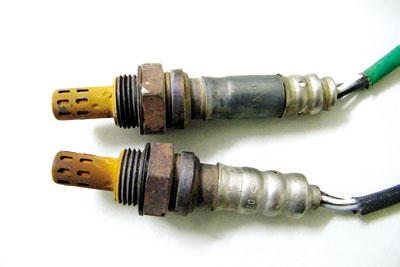 1. Influence of Climate on Oxygen Sensors Under normal circumstances, changes in climatic conditions (fluctuations in temperature, humidity, and air pressure) will have different degrees of influence on the stability of the performance of oxygen sensors. The change in temperature will affect the oxygen transmission rate of the oxygen-permeable membrane, thus affecting the diffusion current. With the thermistor compensation can compensate for the deviation caused by a part of the temperature fluctuations, so that it becomes the original 1/2 to 1/3. Some oxygen sensor surface gas permeable membranes have a strong ability to adhere to water vapor, and the oxygen permeability decreases with the increase of humidity, resulting in a decrease in the performance of the oxygen sensor. Therefore, when selecting the oxygen sensor gas permeable membrane, it should be selected The adhesion is not strong, and the adhesion to moisture is also a relatively stable breathable film. Atmospheric pressure fluctuations can cause sensor performance to fluctuate simultaneously. Many countries are currently studying ways to eliminate the effects of atmospheric pressure fluctuations on the performance of oxygen sensors. One of the methods is to use a wall of the tank to install a pressure buffer. This kind of pressure buffer is essentially a The breathable membrane, using this membrane's cushioning, can reduce the effect of atmospheric pressure fluctuations on the performance of the oxygen sensor.
1. Influence of Climate on Oxygen Sensors Under normal circumstances, changes in climatic conditions (fluctuations in temperature, humidity, and air pressure) will have different degrees of influence on the stability of the performance of oxygen sensors. The change in temperature will affect the oxygen transmission rate of the oxygen-permeable membrane, thus affecting the diffusion current. With the thermistor compensation can compensate for the deviation caused by a part of the temperature fluctuations, so that it becomes the original 1/2 to 1/3. Some oxygen sensor surface gas permeable membranes have a strong ability to adhere to water vapor, and the oxygen permeability decreases with the increase of humidity, resulting in a decrease in the performance of the oxygen sensor. Therefore, when selecting the oxygen sensor gas permeable membrane, it should be selected The adhesion is not strong, and the adhesion to moisture is also a relatively stable breathable film. Atmospheric pressure fluctuations can cause sensor performance to fluctuate simultaneously. Many countries are currently studying ways to eliminate the effects of atmospheric pressure fluctuations on the performance of oxygen sensors. One of the methods is to use a wall of the tank to install a pressure buffer. This kind of pressure buffer is essentially a The breathable membrane, using this membrane's cushioning, can reduce the effect of atmospheric pressure fluctuations on the performance of the oxygen sensor. 2. Lifetime and Reliability of Chemical Oxygen Sensor Due to the influence of electrode structure, electrolyte material and production process, the reliability of electrochemical oxygen sensor is low and cannot meet the requirements for use. It is an objective reflection of electrochemical oxygen sensor to maintain its performance index. The ability to analyze and evaluate the reliability of an electrochemical oxygen sensor and establish a relationship between the reliability of the sensor over time and the relationship between the characteristic parameters is of great significance. One of the methods is to randomly sample the same batch of products, perform life test first, and then perform statistical inference and failure analysis of the life distribution model based on the test data. The main indicators of failure analysis are sensitivity, measurement range, and measurement accuracy. According to the enterprise standard Q/UN2585-298, when the accuracy of the oxygen sensor measurement is <±1%, the sensitivity change and the change of the measurement range can be reflected by the measurement accuracy. Therefore, the detection parameters in the life test are determined as the measurement accuracy. If the measurement accuracy of the sensor exceeds ±1%, the sensor is judged to be invalid.
3. Residual Current Problem When the oxygen content of a gas sample is zero, the diffusion current of the sensor is not zero. This current is called residual current or leakage current (I c ). When the sensor state is new and the electrolyte is pure, I c is small and negligible. However, as the sensor is contaminated with impurities and changes in pH during use, I c gradually becomes larger, which will affect the measurement accuracy of the instrument. Therefore, residual current correction (using high-purity nitrogen or ammonia gas to periodically correct the residual current) should be provided in the instrument design, which ensures the instrument's high accuracy during use.
SLC 500 Controllers
Our Bulletin 1747 SLCâ„¢ 500 control platform is used for a wide variety of applications. Rockwell Automation has announced that some SLC 500 Bulletin numbers are discontinued and no longer available for sale. Customers are encouraged to migrate to our newer CompactLogixâ„¢ 5370 or 5380 control platforms.
Features
- Ladder-logic and structured-text programming
- Advanced instruction set including file handling, sequencer, diagnostic, shift register, immediate I/O, and program control instructions
- Built-in RS-232/422/423 communication port
- DeviceNet and ControlNet I/O on selected processors
- One or more on-board ports that can be configured for either Data Highway Plusâ„¢ (DH+) or Universal Remote I/O
- Universal Remote I/O ports can be configured as an I/O scanner port or an I/O adapter port
- Ethernet PLC-5® controllers and the Ethernet Interface Module (1785-ENET) provide built-in web services
- Backup options for increased fault tolerance through the ControlNetâ„¢ Hot Backup module or the PLC-5 Backup Communication module
AB Slc 500 System Modules,Slc 500 System Processor,Allen Bradley Slc 500 System,Plc Slc 500 System Processor
Xiamen The Anaswers Trade Co,.LTD , https://www.answersplc.com